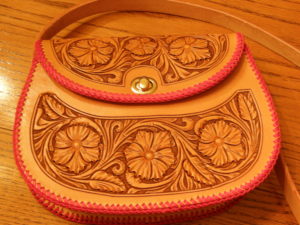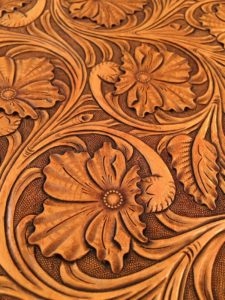There are a lot of different types of leather and many terms that can be confusing even to those who normally work with the stuff. Here is a short list of some of the more common terms you will find on this website or in the industry. This list doesn’t cover all the types and terms used in the industry but it does cover many of the common ones.

Cordovan
Back leather from horses tanned with special processes to make it withstand water and wear well.
Full Grain Leather
The grain side of the leather is not sanded or otherwise treated to hide scars or marks.
Chrome Tanned Leather
Leather that has be tanned with chromium salts. This kind of leather often has a blue-green center and is somewhat water repellant. It is one of the most common types of leather consumers see on a day to day basis. Almost all your clothing leathers are made by this technique.
Suede
Leather cut from the back side of a hide of full grain leather and is often brushed or abraded to give it a velvety surface.
Napa
Usually an aniline dyed calfskin, sheepskin or goatskin. Usually a very soft leather. These types of leather are used when exceptional softness and a luxury feeling are needed.
Nubuck
An aniline dyed leather that has been sanded or buffed on the grain side. Sensitive to dirt and hard to clean.
Elk
Soft and durable leather made from Elk hides.
Deer
Soft and durable leather made from deer hides. Generally does not come from wild animals but instead from animals raised in captivity.
Kangaroo
A durable and soft leather commonly used in braiding items like whips. Also useful in high wear items.
Ostrich
Made from ostrich hides and frequently used in fashion items. The leather has distinctive surface with raised bumps where the feathers used to attach. Sometimes this also refers to leather made from the legs of the ostrich which has a bumpy or almost scaly look.
Rawhide
Untanned leather that is scrapped, soaked and treated with lime to make it stiff and brittle when dry. Used in some leather products for its toughness.
Split Leather
This is the bottom of a full grain hide that has been cut off with a long sharp knife. This can be used to make suede or it can be stained and finished to look like full grain leather as a low cost alternative to a full grain hide.
Vegetable Tanned Leather
This leather is tanned using plant extracts that give it special properties that allow it to be carved or stamped. The process is lengthy and sometimes takes months. This is the kind of leather I use for all the carved or stamped items I make. It’s also the kind used to make western saddles.
Alligator Leather
Leather made from the skins of alligators. Recognizable by the large scales and can be easily mistaken for Crocodile leather.
Crocodile Leather
Very similar to alligator leather except crocodile hides can often have knobby projections from the surface.
Crust Leather
Crust is a term used for leather that has been tanned but has not had dyes or finishes applied.

